This is my review of the Alesis Recital 61 entry level digital piano. I previously reviewed the 88 key version of the Recital (which is the best selling digital piano on Amazon by the way!). It’s really not hard to understand WHY it’s the best-selling piano on Amazon; that one has 88 true full size SEMI weighted keys, it only has 5 sounds but they’re decent sounds, it has line out ports, it has OK speakers, and it only sells for around $225 USD! And while semi-weighted keys are definitely not as realistic feeling as fully weighted hammer action keys; THEY ARE A MASSIVE amount better than non weighted synth action keys; so given the crazy low price? The Recital can be a pretty awesome option for someone who is either just starting out, or is on a budget, or who wants something that weighs less than other pianos for portability’s sake.
A couple years back in my channel someone asked me “what is a good super portable option for a piano player that is accustomed to playing fully weighted keys?” I was curious about that myself, so I started reviewing a bunch of different keyboards to check that out; I reviewed the Yamaha Piagerro NP32 and PSR-E373, the Korg EK-50, the Roland GO:Piano, and the Casiotone CT-S300 & CT-S1. After doing all those reviews, I felt the Casiotone CT-S1 was the best option, so I actually bought one. But in all of those reviews, when I got to the “other options” part of my review, I always mentioned the Alesis Recital 61 as an interesting option; the Recital 61 is basically the EXACT same keyboard as the Alesis Recital, except it has 61 keys instead of 88, but it also has 10 voices instead of only 5! Well on black Friday this year, I saw the Recital 61 on sale so I thought it was about time I bought one of these and did a review. So – with all that out of the way? Here is my review on the 61 key version of the best selling piano on Amazon . . . the Alesis Recital 61; at the end of this review, I’ll comment on how the Recital stands up against my Casiotone CT-S1.
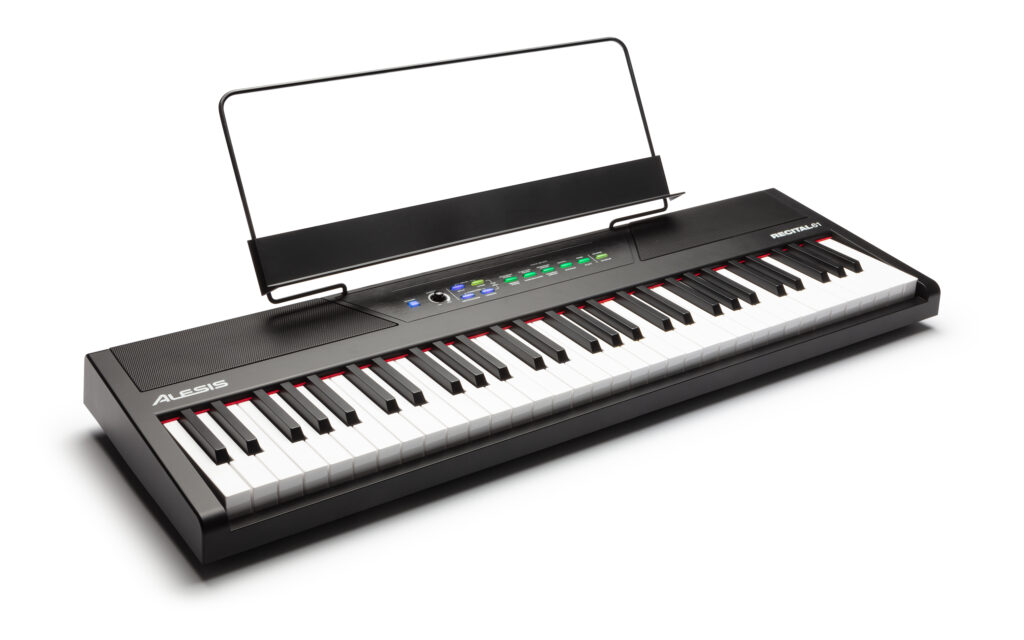
Alesis Recital Review – The Summary
The Keys
61 TRUE full sized semi-weighted keys with 4 levels of touch sensitivity
The Voices
10 voices, accessible with 5 easy buttons, 128 notes of polyphony
The Effects
Chorus & reverb; 5 variations of each effect, and pedal resonance setting
Connectivity
Headphone (1/4″), L/R lines out (RCA), MIDI USB out, 1/4″ sustain pedal input (no pedal is included)
The Rest
- Metronome
- Transpose capability
- Layer mode
- Split mode
- Lesson mode
- 20 watts of speaker power
Alesis Recital Review – The Details
The Keys
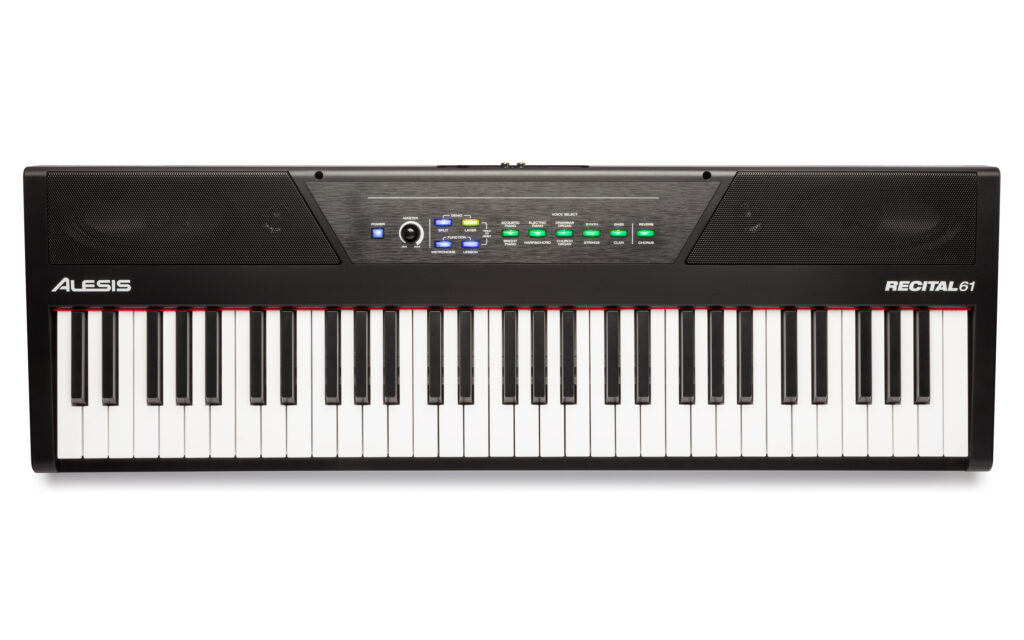
The Alesis Recital 61 has 61 TRUE full size semi weighted keys, with 4 levels of touch sensitivity. While it is marketed as “semi weighted” I’m kind of assuming that just means “stiffer springs” as opposed to actually having weights inside, but I could be wrong (I might need to take this piano apart one day and have a look). But the action on the Recital is most definitely MUCH heavier feeling than synth action keyboards like the Yamaha’s PSR-E series or Piagerro series, or the Casiotone CT-S300. And while the Roland GO:Piano has a SLIGHTLY heavier feel than those prior 3 keyboards, and the Casiotone CT-S1 is SLIGHTLY heavier still (and I have described the CT-S1 as feeling “almost” semi weighted); the Recital still has a noticeably heavier and more . . . . “piano-like” key action and playing experience than any of these other keyboards.
And by “TRUE full-size keys” I mean an octave width of 164-165 mm. I seem to be the only reviewer that ever notices or at least ever talks about this, but almost all non weighted synth action keyboards that say “full size keys” actually have a narrower octave width of 159-160 mm, and quite often slightly undersized and(or) oddly shaped black keys.
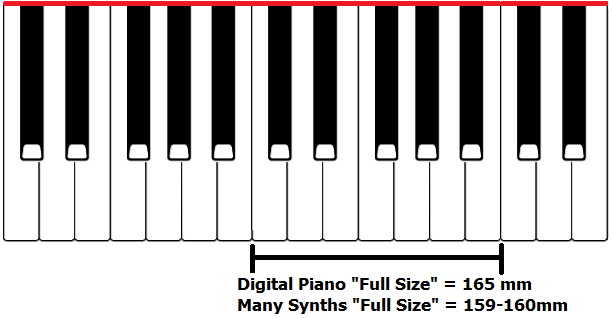
For example, the black keys on my Casiotone CT-S1 are not only a mm narrower than the keys on the Recital, but they also have subtle rounded edges:
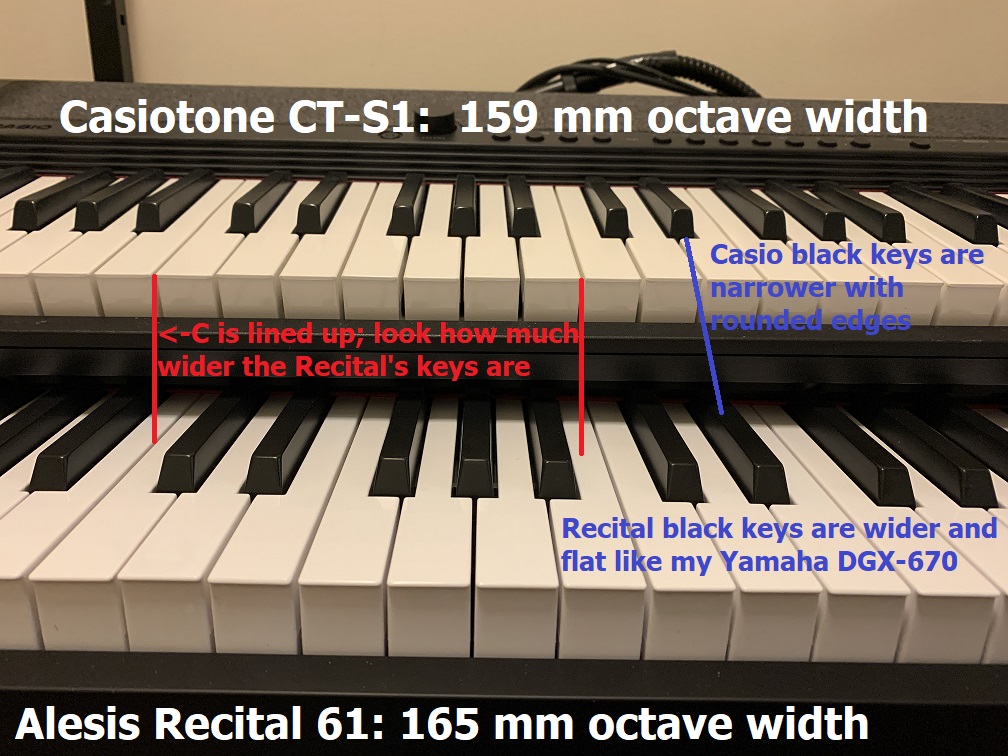
in contrast, the black keys on the Recital are pretty much the EXACT dimensions and flat boxy shape as the black keys on my Yamaha DGX670 piano. It’s not a huge difference, and maybe more advanced players than I have no issues transitioning back and forth between those 2 sizes, but I have to admit I always have found that to be challenging; I can get used to one or the other if that’s all I play, but going back and forth can be frustrating at times. And since non weighted synth actions are very light and easy to press; I often end up grazing keys by mistake and sounding incorrect notes as a result. So out of all the keyboards I listed above, the Yamahas and Casios all have narrower octave widths of around 159-160mm; only the Roland GO:Piano and the Korg EK-50 have what I call “true” full size keys with octave widths of 165mm.
So how do these feel to play for someone used to playing a fully weighted key action like on my Yamaha DGX-670 piano? For me, the proper octave width and the heavier resistance definitely make the Recital 61 easier and smoother for me to transition to than any of the other keyboards I mention above. And also note that the action on the Recital 61 is exactly the same as on the 88 key version of the Recital. Ever since I got the Recital and started exclusively playing it or my Yamaha DGX, I can transition between those 2 very easily; if I go to play my CT-S1 or Yamaha PSR-EW425, I always start making mistakes, hitting keys by accident.
The Voices
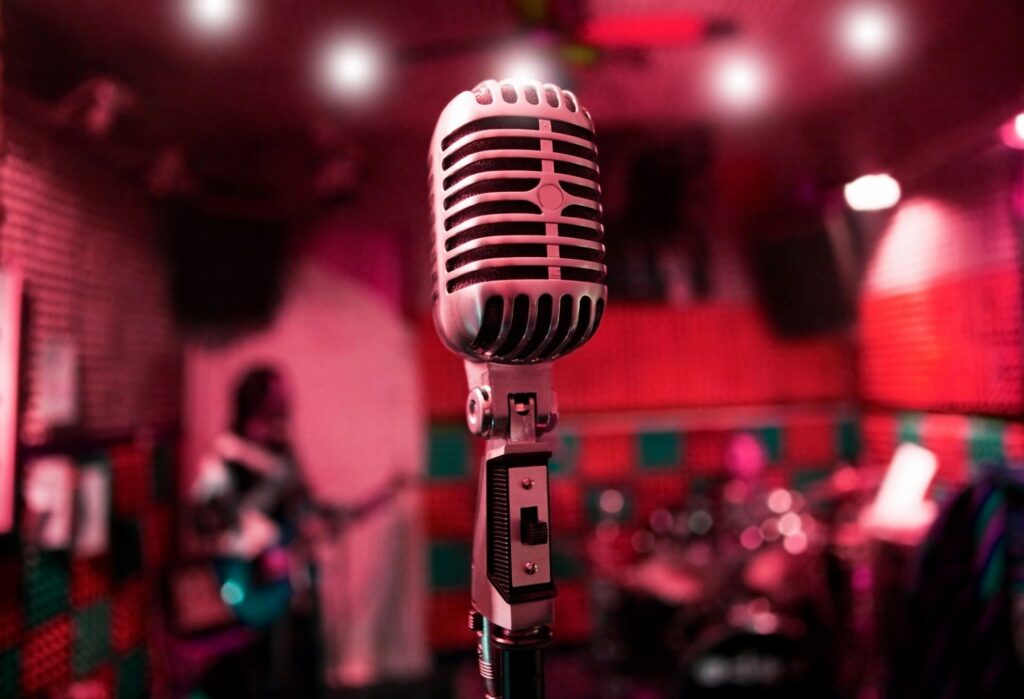
For voices, the Alesis Recital 61 has 10 really well chosen “bread and butter” voices, and for a piano at this low a price? A whopping 128 notes of polyphony. The 10 voices include the renamed but identical 5 voices found on the 88 key version of the Recital which are “Grand Piano, Electric Piano, Drawbar Organ, Synth and Bass”, and then Alesis really fills in some commonly used voice options by adding a second brighter piano, a harpsichord, a church organ, strings & a clavichord. After having reviewed the 88 key version, I was quite excited to see this, especially the addition of the brite piano and strings, which are both voices that I can see myself using quite a bit; and anyone playing in a church will be happy to see the church organ added.
Voices are super easy to select, split and layer, I will go over all of that in the next section of the review; but how do they sound? Not bad at ALL, especially for the price. The main grand piano that’s common to the 61 and 88 key versions of the Recital is totally ok, but the Brite Piano that’s only on the 61 is an awesome addition; I can actually see myself using this more often; it cuts through a mix much better than the main Grand Piano which sounds good, but is a tiny bit muddy. The electric piano sound, which is meant to be a Rhodes, is pretty good as well, as with most budget level pianos, it could do with a bit more “bark” in the low end, but I have to admit when I enable both the reverb and the chorus on this voice? I quite like it. Now the main drawbar organ, especially with the rotary chorus effect enabled? That voice is fantastic. Here is a quick demo on the 10 voices on the Alesis Recital 61.
User Interface, Split, Layer & Lesson Modes

When it comes to user interfaces, my main sticking point is: can I see what my current settings are, and can I change the most common settings I need to change quickly and easily.
Even though there is no fancy screen or anything on the Recital pianos, I’ve always really liked the user interface, because it is SOOO dead simple to use. Granted, part of that ease comes from the fact that there aren’t many sounds, and there are no extra features like rhythms. But, you can just glance at the controls, and you IMMEDIATELY know what voice you have selected, whether the keyboard has been layered and/or split, and if so, what the layered voices are. You also know whether you have reverb and(or) chorus turned on. There are pianos that cost between $700 to $900USD like the Casio PX-S1100 or Roland FP-30X where you can’t even look at the piano and tell what voice you have selected and to select a voice . . . it’s a function key combination!
So each voice on the Recital is labelled and easily selectable with a button; there is a label above and below each button so you press it once for the top voice (button turns green) or twice for the bottom voice (button turns red).
Layering Voices: press the layer button, it turns green – you then select your main voice; then you press layer again and it turns red, then you select your second voice. Then press layer once more and it turns amber and you’re good to start playing. And note that you will see the 2 voices you have selected indicated while you’re in layer mode. If you press Layer when it is amber, you exit layered mode.
Split Mode: select your main voice first, then press and hold split while selecting your second (so left hand) voice. Release the split button and it will be lit and you are in split mode. And then just press it again to exit split mode.
And it’s also easy and intuitive to SET the split point – you hold down the split button and press the key where you want the split point. And note that the Recital will remember the split point you set when you turn off the keyboard.
For both layered and split voices, you can adjust the relative volume of each, which is a fantastic feature at this price; but this is one of the settings that you unfortunately need to look up a function key combination in the manual in order to set. BUT! a super important thing to note here; unlike MANY pianos, including some that cost FAR more – the default relative volume settings for layers (the most common example is piano over strings) ARE TOTALLY USABLE RIGHT OUT OF THE BOX! Here is a quick video with some layer and split examples.
So while it IS a cool feature to have the ability to edit relative volumes? I probably never will, so . . . these are function key combinations that WON’T annoy me, because . . . I won’t need to use them.
And also, note that you can have split and layer modes enabled at the same time – the split voice will be in the left and both layered voices will be in the right.
Now, there is also a lesson mode that splits the keyboard into 2 halves with the same voice and octave range, which is meant to have a teacher sit beside you, but . . . on a 61 key keyboard that only has one headphone output? Probably not a feature that will see much use 😊
Now for effects, you can enable reverb and(or) chorus by just hitting the button once for Reverb (it turns green), a second time for just chorus (it turns red) and once more for BOTH reverb and chorus (it turns amber). Nice and simple! To choose between the 5 TYPES of reverb or chorus, you do need to use function key combinations.
So now; the dreaded function key combinations. While I do . . . well . . . DESPISE having to use function key combinations on a piano, the nice thing about the Recital is that there is only ONE that I see myself using on any kind of a regular basis, and it only requires that I remember 2 keys, so . . . while not ideal, it’s not too bad. And, one nice thing about the function mode on the Recital is that instead of having to hold down a function button while you simultaneously press your settings, you just press “metronome” and “lesson” at the same time to enter “function mode” and then you can let go and make as many settings adjustments as you like; once you’re done, you press them again to exit function mode. Ok so here are the things you need to use key combinations for:
- Setting touch sensitivity (having this as a function key combination to be honest isn’t a big deal, since you do this ONCE and the keyboard will remember it when it’s turned back on)
- Transposing the keyboard – this is the on I do see myself using a lot – Alesis could have made the already good user interface that much better, by just adding a + and a – button to the panel for transposing up or down, press both to reset to the key of C, or something like that; so these are function keys I will either need to label on the keyboard or memorize
- For octave switching – there is an octave switch setting, but it only applies to the lesson mode, where the keyboard is split into 2 halves, each with the same octave – this was a bit of a letdown for me, because on 61 key keyboards, I often like to be down an octave; so to accomplish this now, I have to use the transpose keys instead and go down 12 steps which is an octave, and then reset to default to move back up; adding normal octave switching buttons to the panel would be a MASSIVE addition on the Recital 61
- You can adjust the relative volumes of split and layered voices, which could be handy, but as I mentioned, the piano over strings is great right out of the box, so I will probably never use that
- Setting metronome tempo and time signature (I’m fine with this, because I never use a metronome anyways) 😊
- Choosing reverb or chorus TYPES; while you can turn reverb or chorus on or off using the panel buttons, to change the TYPES you DO have to use function keys; this isn’t the end of the world to me, because I honestly don’t change these settings much on any keyboard I use anyways; and also, note that the keyboard WILL remember your reverb and chorus types when it restarts
- Turning pedal resonance on or off (this gets remembered when the keyboard is restarted); this is also ok for me because it only applies to the piano voices anyways, so I can leave it on
Effects

So for effects, the Alesis Recital 61 has 5 choices for both reverb and chorus, and there is also an optional pedal resonance for the piano voices (note that if you enable pedal resonance, it disables chorus; that’s ok for me because I never use chorus on a piano voice). For reverb, there are 3 choices that are basically increasing amounts of reverb, and then there are 2 reverb delay options. For chorus, there are also 3 choices with increasing amounts of chorus, then there a flange and a rotary option. Since the keyboard remembers my effects settings, I’ve settled on the middle level of reverb as my default setting, and for chorus, while a bit of chorus sounds cool on the electric piano, the rotary sounds fantastic on the organ, so I’ve left that as the default and I only enable chorus when I’m using the organ.
Now the Recital 61 also has “Pedal Resonance”; this is disabled by default, but can be enabled if you want a slighty more realistic piano playing experience, but note that when pedal resonance is enabled, chorus is disabled. What is pedal resonance? When you press down the sustain pedal on an acoustic piano, it lifts the dampers off ALL of the strings, which makes it possible for ALL strings to vibrate; so when you play 1 note which strikes that string with a hammer causing it to vibrate, any other notes that are harmonically related to that note will vibrate slightly creating a resonant sound. Since I play one of the piano voices 90% of the time and never use chorus on a piano voice, I’ve enabled pedal resonance.
Here is a quick video on the reverb and chorus options, as well as pedal resonance:
Connectivity
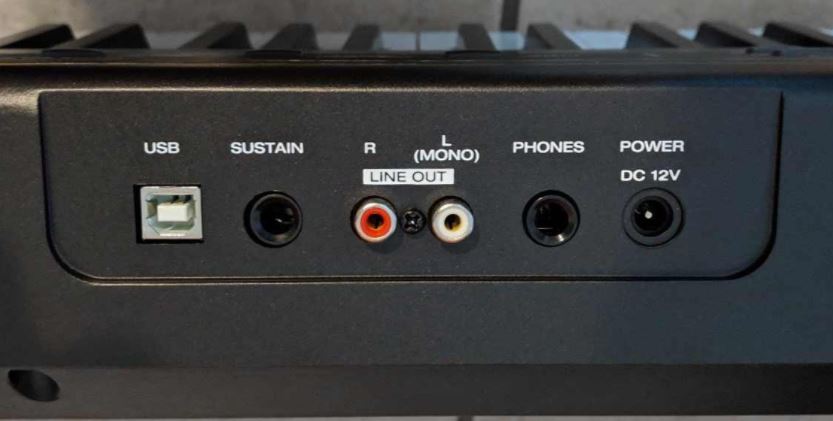
For connectivity, the Alesis Recital 61 does quite well, although it is missing one feature that would be SUPER nice to have. On the back of the Recital we have:
- A ¼” headphone port
- A USB to host port for sending MIDI data to a device if you want to use the Recital as a MIDI controller
- A ¼” generic sustain pedal port
- L/R line out ports for connecting to external audio equipment like PA’s, amplifiers, mixers or audio interfaces – this is a very welcome feature and pretty rare at this price, especially for a super portable gigging option for things like busking; these ports will not only send a cleaner, higher quality signal to an amp than a headphone port will, but having these ports also means that the 20 watt speakers will still be active as monitors to help me hear myself.
On almost ALL the other super portable keyboards I’ve tested, including my Casiotone CT-S1, I have to use the headphone port to connect to an amp which mutes the onboard speakers. It is a bit strange that these ports are RCA instead of the usual ¼” TR ports, but they still work the same and there are lots of cables and adapters out there; I bought a nice RCA to TR cable on Amazon for about $15.
The one thing I REALLY wish the Recital had is an aux in port; this would allow me to stream backing tracks in from my iPad to play along with. But not the end of the world, I can always use a portable mixer for that, or just use another port on my portable PA for the backing tracks.
Speakers
The speakers on the Alesis 61 are 20 watts, and are decent sounding, but by no means spectacular. BUT . . . they are plenty loud for practice, and will be super handy to have enabled as monitors while connected to an amplifier. Here is a quick video on the speakers:
The Other Features
- 2 built in songs, and a built in short demo of each voice
- Auto power off after 30 minutes
- Restore factory default settings (this is easy to do, just hold layer and lesson for 5 seconds); I do actually use this once in a while – since there is no display, if I’ve accidentally changed something in function mode, this is a quick way to reset everything if needed
What’s Missing / Could Be Improved?
- Aux in to stream in backing tracks, piano lessons etc
- Just a COUPLE more quick access buttons for transposing (so you don’t have to do that in the function menu)
- +/- buttons to transpose keys up and down
- +/- buttons to shift octaves up and down
- buttons to chose chorus / reverb TYPES
- Needs a better music rest!
- The totally open design for the music rest doesn’t hold up a tablet, and paper or books easily fall through – a solid plastic rest or at least another bar half way up would be a huge improvement
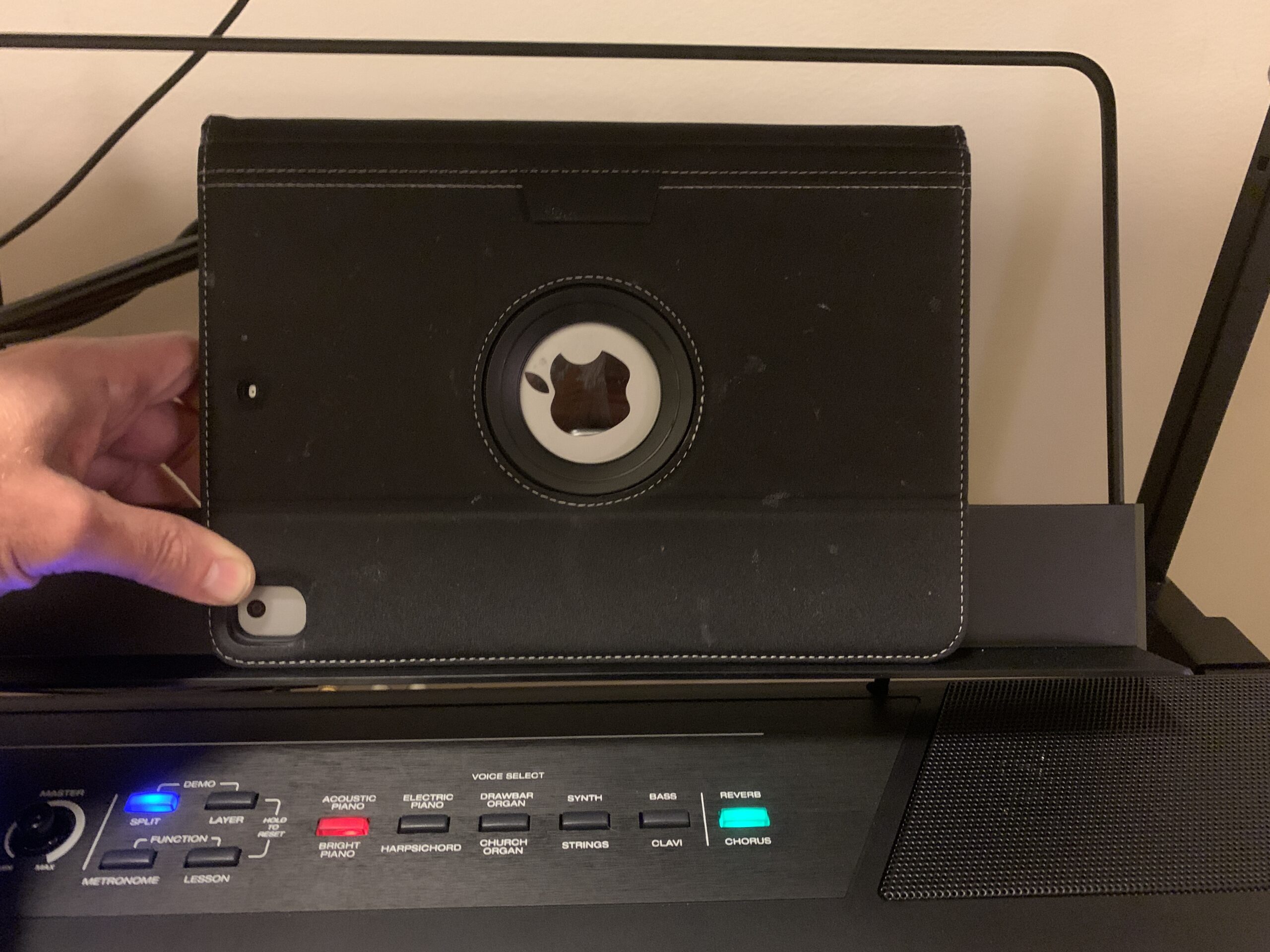
- The totally open design for the music rest doesn’t hold up a tablet, and paper or books easily fall through – a solid plastic rest or at least another bar half way up would be a huge improvement
The Other Choices
So I mentioned the list of all the keyboards I’ve reviewed before in trying to find a super portable option for a piano player who is used to playing fully weighted keys, and the 2 that stood out were the Yamaha PSR-E373 and the Casiotone CT-S1, with the Casiotone CT-S1 being the one I settled on and typically recommend to fill that need.
Alesis Recital 61 ($200USD) vs. Yamaha PSR-E373 ($200USD)
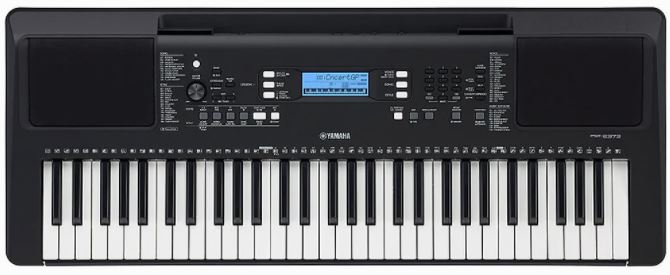
The Yamaha PSR-E373 IS a fantastic keyboard, with a great user interface that includes a screen, tons of voices including a VERY high end piano sample, built in rhythms and arranger features AND an audio interface built into the USB port. BUT the PSR-E373 has no line out ports, it has a narrower octave width, slimmer rounded black keys, and a VERY LIGHT synth action feel. Transitioning back and forth between a piano with true full size fully weighted keys and the PSR-E373 can be pretty challenging, at least for me.
The Alesis Recital 61’s sounds aren’t QUITE as good (although the organ might actually be better), but the sounds are decent and totally usable, and the Recital has line out ports, and provides a far more “piano like” playing experience because of the familiar key size, shape and semi-weighted feel.
Alesis Recital 61 ($200USD) vs. Casiotone CT-S1 ($220USD)
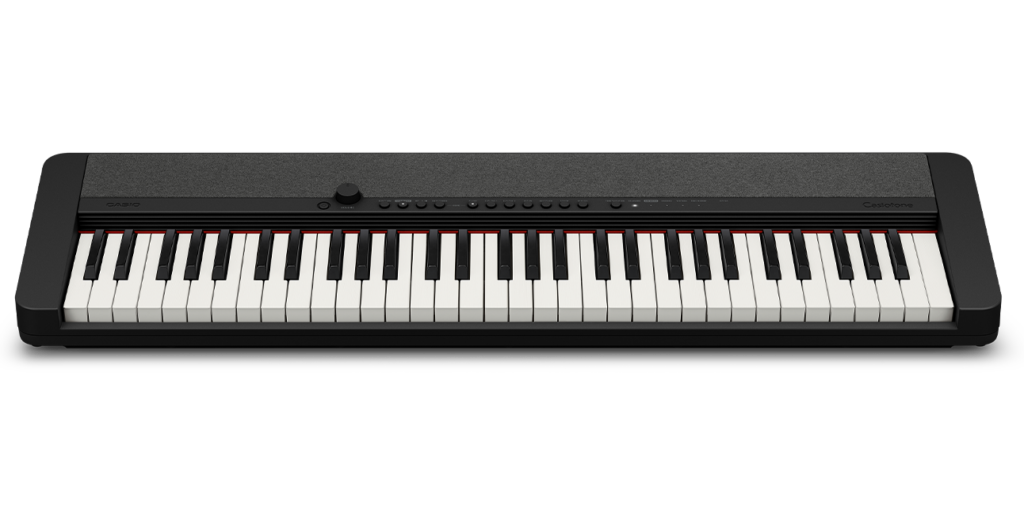
The Casiotone CT-S1 is a fabulous keyboard with tons to offer; it has great voices and a great user interface for selecting MAIN sounds, but that interface becomes frustrating when it comes to selecting voices not tied to the panel buttons, and also for layering voices because those things require memorizing function key combinations. The CT-S1 definitely offers a more piano like playing experience than the Yamaha PSR-E373 with keys that offer more resistance and are ALMOST a semi weighted feel.
BUT, like the Yamaha, the CT-S1 still falls short of the Alesis Recital 61 in a few key areas:
- it has no line out ports, so you lose the use of the speakers when connecting to external amplification
- if you DO have voices layered (with key combinations), you can’t just glance at the keyboard to see what your current selections are
- while the keys are heavier than the PSR-E373, they are still not as heavy as the Recital’s, AND like the Yamaha, they have a narrower octave width, and the black keys are narrow and slightly rounded, so once again, the Recital provides a much more “familiar” playing experience if you’re used to weighted keys
Alesis Recital 61 Review – The Verdict

So what is my verdict on the Alesis Recital 61? Basically what it comes down to is what is important to YOU? If you are looking for a super portable keyboard that is easy to transition to from a fully weighted piano, that can be used to perform with (in a low key setting like busking) I think the Recital 61 is my new favorite option. While keyboards like the Yamaha PSR-E373 or Casiotone CT-S1 are both great keyboards, the Recital 61 simply provides a much more piano like playing experience and feel than either of those keyboards, and with a small but well chosen set of decent sounds, super simple, easy and intuitive user interface and proper line out ports for connecting to external audio? It’s definitely my top choice for the use case I’m testing it for.
Now where this decision can get muddied a little bit is; would I recommend buying the Recital 61 for your ONLY keyboard or piano? In that case, it would depend on whether the portable performance features (line outs and easy, functional user interface) are more important to you than the slightly higher quality sounds on the Yamaha or the Casio? If the performance features matter more, I would recommend the Alesis Recital 61, but if making recordings with higher quality voices matters more to you, then you might want to lean towards the Yamaha or Casio. For me, my main piano is my new Yamaha DGX-670 which I absolutely love, but it is 50 lbs and VERY far from being portable, so the Alesis Recital 61 is perfect as my new go-to option for a super portable keyboard.
And keep in mind, if you are looking for an entry level digital piano but don’t want to break the bank with your first purchase, that the Alesis Recital 61 or the 88 key version, the Alesis Recital are great options for getting started, since they at least have true full sized SEMI weighted keys.
So with all that in mind, I would definitely recommend the Alesis Recital 61 as a super portable option for a piano player.
Thanks so much, and happy piano playing! (and piano shopping 😉 )
I have included links below to Amazon so that you can check current pricing – please note that as an Amazon Associate I earn from qualifying purchases
Fully Weighted Budget Options:
If you have any questions about my experience with the Alesis Recital 61, please feel free to contact me
